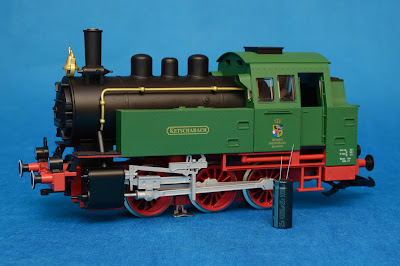This was easily visible with the small Piko BR80 locomotive. The model does not offer that many points of contact with the rails and is not very heavy, either. At one point in time I became actually worried about its jumpy performance but a test run on a brand new track proved the engine was fine. The problem was just the dirty garden layout...
What could I do about it? Could I somehow add a capacitor just like I did in the case of my flicker-free lights? Perhaps that capacitor could be very cheap, too?
I opened the Piko 36121 decoder manual and to my surprise I found a chapter describing exactly what I wanted to achieve. The designers of the electronics have foreseen the issue and gave us an option to mitigate it.
The manual mentions Massoth Powercap product which offers a huge energy buffer that allows the locomotive to free-run for several seconds. There are Youtube videos showing that this solution works extremely well. There are however two issues with the Massoth product:
- Its buffer is too big. I do not want my locomotive to keep going half a loop after I cut the power. I want it to stop quickly. What I want is just to avoid the issue of a dirty track. So an energy cell providing just 1 second of electricity should be enough.
- The price. Powercap is listed between 40 and 60 Euro depending on the version. That's too much for my taste...
I disassembled the locomotive looking for a place to install the new element. Turns out there's a plenty of room in the front of the boiler. Since this was an experiment and I might have wanted to change my mind later, I decided to go for a solution that would not force me to open the model again anytime soon. So instead of simply installing the capacitor, I've exposed two cables in the front part of the locomotive.
One cable is connected to the decoder "plus pin" - the same that many other modules use. The other extends the "GND pin" - one that was not yet used in my setup. I can now decide to run with or without the capacitor just by opening the front of the boiler. And I can even upgrade easily to a larger element if this turns out to be a good idea!
So... how did the test run go? Well, first of all - the locomotive still works. Nothing exploded. I followed the simple instructions in the manual and managed to do the installation correctly.
I'm not really able to fully test the solution right now, since it's winter and I don't enjoy my garden that much at the moment. Besides it would be difficult to perform a scientifically correct test, as the conditions would be changing all the time. So instead I've recorded a video and analyzed the locomotive's behavior frame by frame with and without the capacitor. Here's my movie:
The results:
- Without any power buffer the locomotive stops almost immediately after the power is cut. Any extra movement is noticeable on only 1 additional video frame which corresponds to a time of 40ms.
- With the power buffer of 10000uF the locomotive continues its motion for a short time after the disconnection. Some movement can be recognized on additional 4 video frames which corresponds to a time of 160ms.
For example - one could buy a larger capacitor. A 22000uF piece is just 2 Euro. Or one could buy more than one capacitor - their buffers will simply add up. The limit is just the space inside the model and it seems there is still some available.
Alright, I consider this experiment a success. The capacitor definitely stays inside my engine. It does something good, it's just difficult to say whether it's good enough. I will continue in spring when I put my BR80 on the dirty track again :)




Hello, Tomasz!
ReplyDeleteI'm looking forward to the "field" tests. Good luck to you.
Yours faithfully,
Dmitry Kudryashov.
Thank you, Dmitry.
DeleteIt's very difficult to perform "fair" field tests. Nonetheless the season has started and I was able to run my Piko BR80 outside already. Of course I expected the first few loops after the winter would be difficult due to dirt on the track. And I remember that last spring the locomotive was very "jumpy" at first.
I was very happy to see that this year's performance was much better. The loco's movement was much smoother than in the previous year. There can be only two explanations:
- either the track was not as dirty as in the previous spring
- or the power buffer actually helps
I have no reason to believe the former was the case. Why would the track be in better shape than it was a year before? Can't find any reason...
On the other hand - I really expected the latter to make some difference. So I believe it does, because the locomotive does perform better now!
For me the power buffer stays in. I have not replaced it with a bigger one, yet, and there seems to be no reason to do that. The engine works great already now!
Hope this helps :)